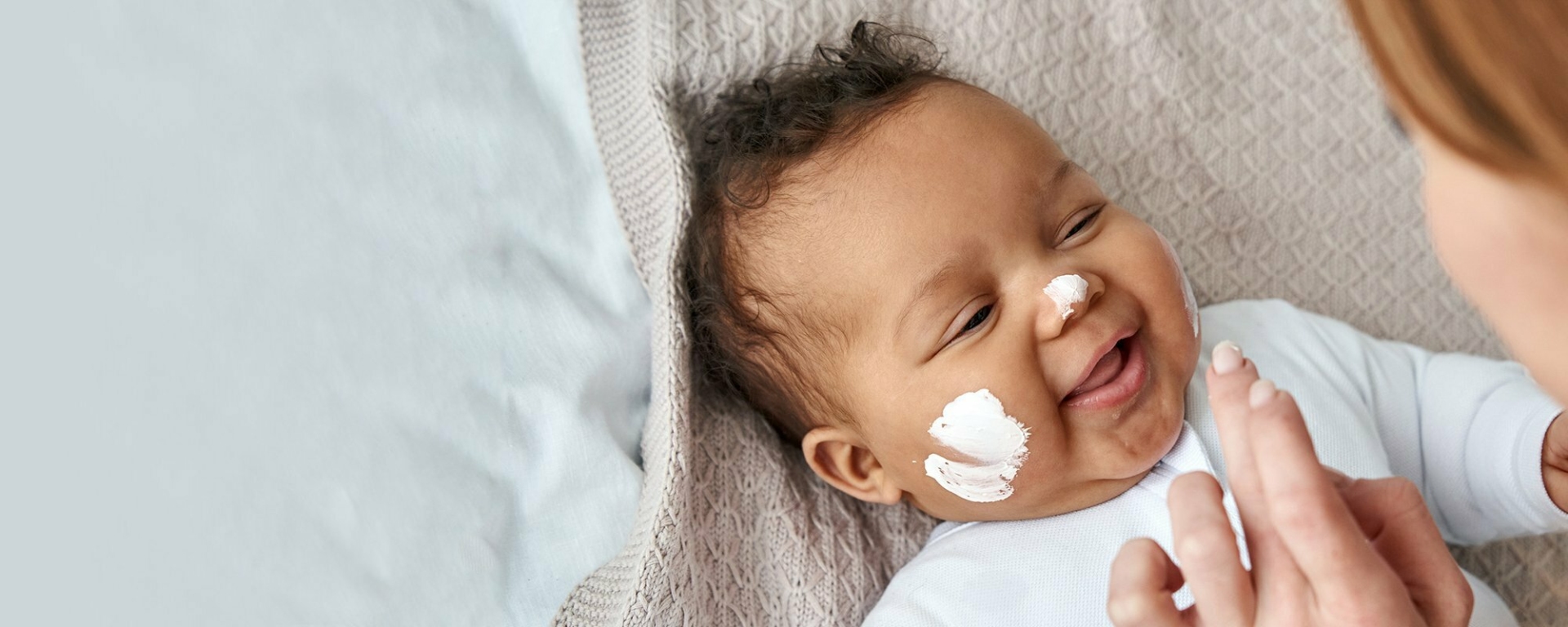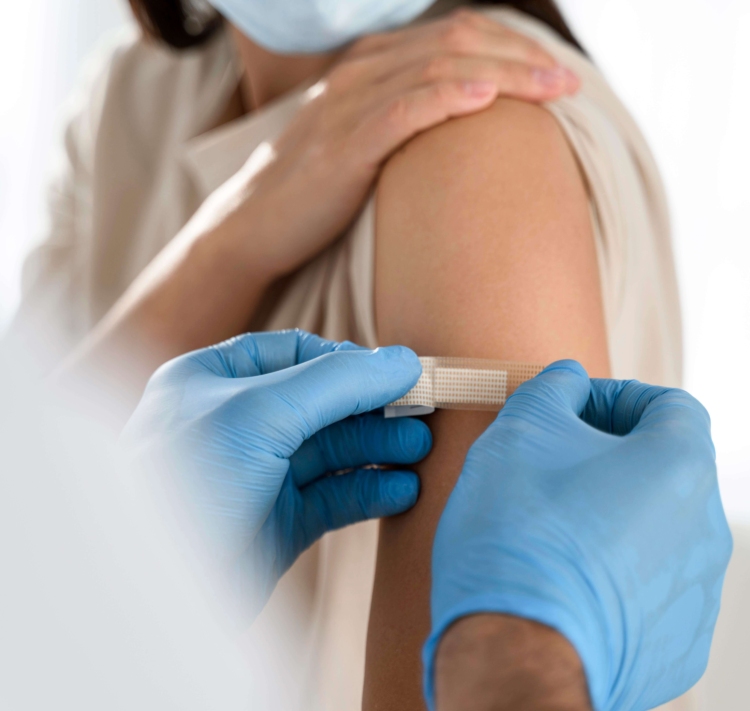The following is an overview of the most frequent problems faced by little ones in terms of their skin:
MILIUM
Symptoms
Small whiteheads slightly bigger than the size of a grain of sand appearing on the nose, forehead, chin or cheeks. This benign issue is caused by an accumulation of grease in pores of the skin and is unlikely to persist.
Characteristics
Only affects newborns (0 to 3 months of age). Outbreaks generally last a few weeks, rarely longer than 2 months. Should they persist beyond 3 months’ time, it is recommended to see a doctor.
Treatment
Milium normally disappears on its own. Clean affected areas regularly, using water and mild soap. No not scratch milium pimples and do not apply and cream or ointment on them.
Transmission
None
CRADLE CAP (aka milk crust, seborrheic dermatitis)
Symptoms
Yellowish patches crusted on baby’s scalp, sometimes accompanied by redness under the arms, in the folds of their skin or the bum. May cause itching. Cradle cap does not pose a risk for the baby.
Characteristics
Can appear during the first weeks of a baby’s life, most often at 3 months of age and up to the age of 6 months. Symptoms generally last 3 to 4 weeks, but can sometimes persist up to 12 months of age.
Treatment
No action is necessary. The condition will go away on its own. You may, however, regularly wash baby’s head using a gentle shampoo designed for babies, but not overly frequently. Applying oil meant for babies or mineral oil can also help to improve the situation. Gently massage the area, and then allow the oil to act before washing it away to remove excess oil. Consult a doctor if your baby’s seborrheic dermatitis lasts longer than 3 to 4 weeks, if there seems to be intense itching or if baby is showing lesions on other parts of the body, such as in the folds of their neck or underarms, behind the ears, on the face (forehead, eyebrows and area between the nose and upper lip), or if affected skin comes into contact with baby’s diaper.
Transmission
None
ATOPIC ECZEMA (dermatitis)
Symptoms
Dryness and inflammation of the skin that may result in the appearance of small reddish bumps. In babies, eczema can affect the forehead, cheeks or scalp, but also arms, legs, chest or even the bum (diaper rash). It causes itching of variable intensity that may provoke irritability in affected children. In some cases, bumps may crust over, and lesions may have some discharge if they become infected.
Characteristics
Atopic eczema is the most common form of eczema. Symptoms of this chronic inflammatory illness manifest during the first year of a child’s life and may reappear at any point during their adult life. One child out of three has eczema, but only half of affected children suffer a relapse.
Treatment
There is no medication to cure eczema, but its effects can be alleviated and controlled. To relieve your baby, give them a cool bath each day and frequently apply fragrance-free hydrating cream on their skin. Loose clothing is recommended, and wool is to be avoided. In severe cases, a doctor may prescribe a topical corticosteroid cream or ointment to reduce inflammation and itching. Before consulting a doctor, see your pharmacist – they can recommend an over-the-counter solution or even write a prescription.
Transmission
None
IMPETIGO
Symptoms
Appearance of small, round clusters of red pimples that form a yellowish crust, generally on the face, nose or forearms, but that may also spread to other parts of the body. Impetigo sometimes appears on a baby’s or young child’s bum. In cases where the intensity of infection increases, the affected child may run a fever and have enlarged glands in the neck. It is then recommended to see a doctor.
Characteristics
Although it is a highly contagious infection, impetigo is benign in the vast majority of cases. It is caused by bacteria that infiltrate scratches or insect bites and mostly affects children aged 4 to 8, but can also occur during adolescence or adulthood. Symptoms generally subside after about 5 days, although lesions may linger slightly longer.
Treatment
It is usually sufficient to regularly wash affected areas with soap and water and to let time do its work. Should the infection worsen, antibiotics may be required, as prescribed by a doctor.
Transmission
Impetigo is transmitted through contact with infected areas or with objects that have come into contact with infected areas. That’s why it’s important to be diligent in terms of avoiding all physical contact during treatment as well as not sharing items that may be contaminated. Impetigo remains contagious as long as infected areas continue to produce discharge, and the risk of transmission persists even 24 to 48 hours following the application of an ointment containing antibiotics.
Seeing as impetigo is a contagious illness, if your child is infected they may not go to daycare or to school as long as they haven’t completed at least one full day of antibiotic treatment.
SUNBURNS AND SUN PROTECTION
Symptoms
Ouch! We’ve all lived through the unpleasant effects and sensations caused by overexposure to the sun’s harmful rays. In babies and young children, consequences may prove to be significantly more serious due to the fragility of young skin. Children are mostly unaware of the risks involved, yet overexposure to the sun during childhood markedly increases the risk of developing skin cancer in the long term.
Prevention
Sunscreen products should not be applied on the skin of babies who are less than 6 months of age. It is recommended to use physical sunblock such as zinc oxide (white powder), which blocks out UV rays by reflecting them. The thing to do is to protect children as much as possible from the sun by keeping them in the shade, making them wear wide-brimmed hats, UV protection sunglasses (min. UV400 or 100% UV) and long clothing.
In children older than 6 months, it is recommended to use sunscreen and lip balm featuring an SPF of at least 30 and bearing the logo of the Canadian Dermatology Association. If your child is fair, an SPF of 45 or 60 is recommended. SPF stands for sun protection factor and provides protection against UVB rays. Sunscreen should be applied at least 30 minutes before sun exposure, as well as every 2 hours and each time after going in the water.
Treatment
If your child is sunburned, have them take a short bath or a cool shower several times a day, and make sure they drink plenty of water. Applying fragrance-free ceramide cream after bathing or showering relieves discomfort.
Speak with your pharmacist
While we are generally able to identify sunburn, it is often difficult to determine the exact nature of skin problems that affect our babies and young children. By visiting your pharmacy or having a virtual consultation with your pharmacist, you’ll get answers to your questions and know the measures to take in order to remedy the situation.
This information is not a substitute for professional medical advice and Accès pharma chez Walmart affiliated pharmacist-owners cannot be held responsible for this information. The information was true and accurate at the time of publication, but it is subject to change.





